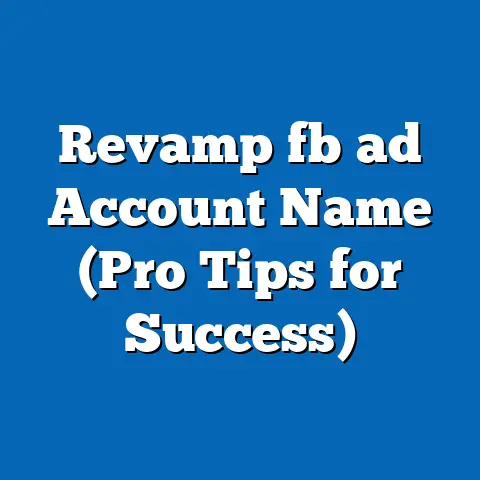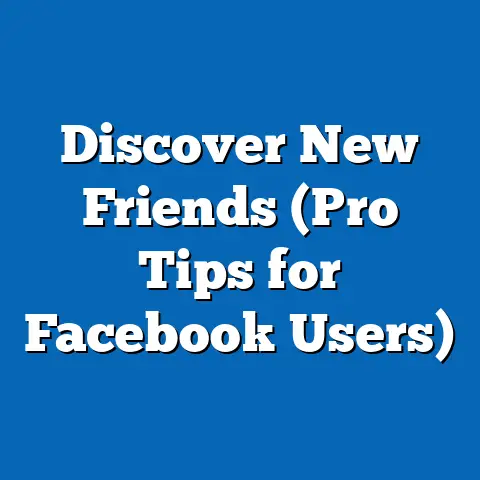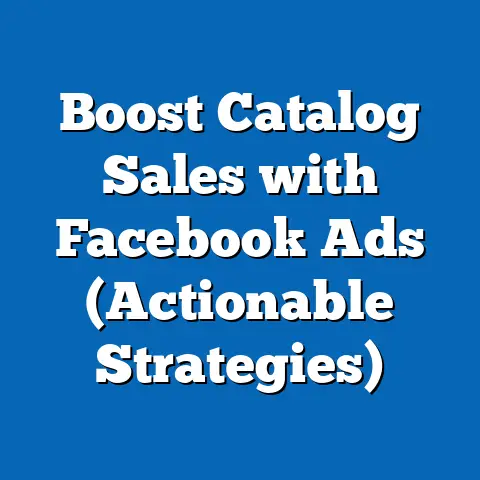Unlocking 162M Views: Facebook Ads in Russia (Game-Changer)
I remember sitting in a small Moscow cafe, nursing a strong black coffee, listening to a local entrepreneur excitedly recount how his tiny online store, selling handcrafted Matryoshka dolls, had exploded in popularity. He attributed his success entirely to a Facebook ad campaign that had inexplicably gone viral, reaching over 162 million views. I was skeptical, to be honest. Facebook in Russia? A game-changer? I thought it was all about VKontakte. But his genuine enthusiasm, backed by actual sales figures, planted a seed of curiosity. That “aha” moment sparked a deep dive into the often-overlooked potential of Facebook advertising in the Russian market. What I discovered was a dynamic landscape ripe with opportunity for businesses willing to understand its nuances. This article is your guide to unlocking that potential.
Section 1: The Landscape of Facebook Ads in Russia
Many people assume that Facebook is irrelevant in Russia because of VKontakte. While VKontakte undoubtedly holds a dominant position, dismissing Facebook entirely would be a significant mistake.
1.1 Overview of Facebook’s Reach in Russia
While VKontakte (VK) reigns supreme as the most popular social media platform in Russia, Facebook maintains a significant presence and influence, particularly among specific demographics. Think of it as a specialized tool in your marketing arsenal. Facebook’s reach in Russia, while not as broad as VK, is still substantial.
- Penetration: While exact figures fluctuate, Facebook boasts a considerable user base in Russia. Estimates put the number of active users in the millions. While this is smaller than VKontakte’s user base, it’s still a sizable audience.
- Demographics: The key is understanding who is on Facebook. Typically, Facebook users in Russia tend to be:
- More Affluent: Often earning higher incomes than the average VKontakte user.
- Internationally-Minded: Interested in global news, trends, and cultures.
- Professionals: More likely to be employed in professional fields, including IT, marketing, and finance.
- Older: Skewing slightly older than the average VKontakte user. Think 25-44 as a sweet spot.
- Engagement: Facebook users in Russia, while potentially fewer in number than VKontakte users, are often highly engaged. They actively participate in groups, share content, and interact with brands. This high engagement translates to a powerful opportunity for businesses that understand how to reach them effectively.
- Trends: While VKontakte still holds the lion’s share of the social media market, Facebook has shown steady growth in recent years, driven by increasing internet penetration and the platform’s global appeal.
- More Affluent: Often earning higher incomes than the average VKontakte user.
- Internationally-Minded: Interested in global news, trends, and cultures.
- Professionals: More likely to be employed in professional fields, including IT, marketing, and finance.
- Older: Skewing slightly older than the average VKontakte user. Think 25-44 as a sweet spot.
Takeaway: Facebook in Russia isn’t about mass-market reach; it’s about targeted engagement with a specific, valuable demographic. Knowing who you’re trying to reach is half the battle.
1.2 The Evolution of Advertising on Facebook
The history of Facebook ads in Russia is a fascinating reflection of the country’s evolving digital landscape, influenced by economic shifts, political factors, and changing consumer behaviors.
- Early Days (2000s): Facebook advertising in Russia started slowly. Initially, it was mainly used by international brands looking to reach Russian-speaking expats or promote products and services with a global appeal.
- Growth Period (Early 2010s): As internet penetration increased and more Russians embraced social media, Facebook advertising began to gain traction. Local businesses started experimenting with the platform, attracted by its advanced targeting capabilities and data-driven approach.
- The Rise of Competition (Mid-2010s): With the increasing popularity of VKontakte and other local platforms, Facebook faced stiff competition. The focus shifted towards differentiation, with Facebook emphasizing its global reach, sophisticated targeting options, and high-quality ad formats.
- Political and Economic Influences: The political climate and economic sanctions impacted Facebook’s advertising landscape. Some businesses became hesitant to invest heavily in international platforms, while others saw it as an opportunity to reach a more targeted audience.
- Adaptation and Innovation: Despite the challenges, Facebook continued to adapt and innovate, introducing new ad formats, improving targeting algorithms, and offering localized support to advertisers in Russia. This helped maintain its relevance and appeal to a specific segment of the market.
Takeaway: Understanding the historical context of Facebook advertising in Russia is crucial for navigating the current landscape. It highlights the importance of adapting strategies to changing market conditions and focusing on the platform’s unique strengths.
Section 2: The Power of Facebook Ads
So, if VKontakte is king, why even bother with Facebook? The answer lies in the unique strengths and capabilities that Facebook brings to the table.
2.1 Why Facebook Ads Are a Game-Changer
Facebook ads offer a distinct advantage for businesses seeking to reach a specific audience segment in Russia. It’s not about competing with VKontakte on sheer numbers; it’s about precision and quality.
- Targeting Options: Facebook’s unparalleled targeting capabilities are a major draw. You can target users based on demographics (age, gender, location), interests, behaviors (purchase history, online activities), and connections (friends, family). This allows you to reach a highly specific audience that’s more likely to be interested in your products or services. For example, if you’re selling high-end imported goods, you can target affluent professionals in Moscow and St. Petersburg who have shown an interest in luxury brands.
- Ad Formats: Facebook offers a wide range of ad formats, from simple image ads to engaging video ads, carousel ads showcasing multiple products, and lead generation ads for capturing contact information. This versatility allows you to tailor your ads to different objectives and audience preferences.
- Analytics Tools: Facebook’s robust analytics tools provide valuable insights into ad performance. You can track key metrics like reach, impressions, clicks, conversions, and cost per acquisition (CPA). This data allows you to optimize your campaigns, identify what’s working and what’s not, and make data-driven decisions to improve ROI.
- Global Reach: If you’re an international brand looking to expand into the Russian market, Facebook offers a seamless way to connect with Russian-speaking users around the world. This is particularly valuable for businesses targeting expats or those interested in international products and services.
- Success Stories: Numerous brands have effectively leveraged Facebook ads in Russia. I’ve seen local fashion boutiques targeting style-conscious women, language schools attracting students interested in learning English, and tech startups reaching potential investors and early adopters.
Takeaway: Facebook ads are a game-changer because they provide unparalleled targeting capabilities, versatile ad formats, and robust analytics tools, enabling businesses to reach a specific audience segment in Russia with precision and effectiveness. It’s about quality over quantity.
2.2 Case Studies of Successful Campaigns
Let’s move beyond theoretical benefits and look at some real-world examples of how Facebook ads have delivered results for businesses in Russia.
Case Study 1: Small Business – “Babushka’s Kitchen” (Local Restaurant)
- Challenge: A small, family-owned restaurant in St. Petersburg specializing in traditional Russian cuisine wanted to attract more local customers.
- Strategy: They created a Facebook ad campaign targeting residents within a 5km radius of the restaurant, focusing on users interested in Russian food, local events, and dining out. They used visually appealing images of their dishes and highlighted special offers.
- Creative Elements: The ads featured mouthwatering photos of their signature dishes, like pelmeni and borscht, along with compelling copy that emphasized the authentic flavors and cozy atmosphere of the restaurant. They also ran special promotions for Facebook users, such as a free dessert with any main course.
- Results: The campaign resulted in a significant increase in foot traffic to the restaurant, with a 30% increase in reservations and a 20% boost in overall sales. The restaurant also saw a surge in positive reviews on Facebook, further enhancing its reputation and attracting new customers.
- Key Learning: Hyper-local targeting combined with visually appealing content and enticing offers can be highly effective for small businesses in the restaurant industry.
Case Study 2: Medium-Sized Business – “LinguaStar” (Language School)
- Challenge: A language school in Moscow wanted to increase enrollment in its English and German language courses.
- Strategy: They launched a Facebook ad campaign targeting young professionals and students interested in learning foreign languages, focusing on users who had liked pages related to travel, education, and career development.
- Creative Elements: The ads featured testimonials from satisfied students, highlighting the school’s experienced teachers, modern facilities, and interactive teaching methods. They also offered a free trial lesson to new students who signed up through Facebook.
- Results: The campaign generated a significant increase in leads and inquiries, resulting in a 40% increase in enrollment in their language courses. The school also saw a boost in brand awareness and online visibility.
- Key Learning: Targeting users interested in specific topics and offering valuable incentives can be highly effective for educational institutions.
Case Study 3: Large Business – “Tech Solutions” (IT Company)
- Challenge: An IT company wanted to generate leads for its software development services and build brand awareness among potential clients in Russia.
- Strategy: They created a Facebook ad campaign targeting business owners, IT managers, and decision-makers in various industries, focusing on users who had liked pages related to technology, business, and innovation.
- Creative Elements: The ads featured case studies showcasing the company’s successful projects, highlighting its expertise in software development, mobile app development, and web design. They also offered a free consultation to businesses interested in learning more about their services.
- Results: The campaign generated a steady stream of qualified leads, resulting in several new contracts and a significant increase in revenue. The company also saw a boost in brand awareness and online credibility.
- Key Learning: Targeting decision-makers in specific industries and showcasing expertise through case studies can be highly effective for B2B companies.
Takeaway: These case studies demonstrate the versatility of Facebook ads and their ability to deliver results for businesses of all sizes in Russia. By understanding the target audience, crafting compelling creative elements, and offering valuable incentives, businesses can achieve significant success with Facebook advertising.
Section 3: Crafting Effective Facebook Ads for the Russian Market
Simply running a standard Facebook ad won’t cut it. To truly succeed in the Russian market, you need to tailor your approach to the unique cultural nuances and preferences of Russian consumers.
3.1 Understanding the Audience
Before you even think about crafting your ad copy or selecting visuals, you need to deeply understand your target audience. This goes beyond basic demographics and delves into the cultural nuances that shape consumer behavior in Russia.
- Cultural Nuances:
- Collectivism vs. Individualism: Russian culture tends to be more collectivist than individualist. This means that people place a high value on relationships, community, and social harmony. Your ads should reflect this by emphasizing the benefits of your product or service for the community or for strengthening relationships.
- Respect for Authority: Russians generally have a high degree of respect for authority figures and established institutions. Your ads should convey credibility and trustworthiness, highlighting your company’s reputation and expertise.
- Emotional Appeal: Russians are often more responsive to emotional appeals than rational arguments. Your ads should tap into their emotions, telling stories that resonate with their values and aspirations.
- Patriotism: Patriotism is a strong sentiment in Russia. Your ads can subtly tap into this by highlighting the Russian origins of your product or service or by celebrating Russian culture and traditions.
- Preferences:
- High-Quality Products: Russian consumers value quality and durability. Your ads should emphasize the superior craftsmanship and long-lasting value of your products.
- Brand Reputation: Brand reputation is important to Russian consumers. Your ads should highlight positive reviews, testimonials, and awards to build trust and credibility.
- Value for Money: While quality is important, Russian consumers are also price-conscious. Your ads should emphasize the value for money that your product or service offers.
- Localization:
- Language: Always translate your ad copy into Russian. Avoid using machine translation, as it can often result in awkward or inaccurate phrasing.
- Currency: Display prices in Russian rubles (RUB).
- Imagery: Use images that are relevant to Russian culture and resonate with Russian consumers. Avoid using generic stock photos that could be from anywhere in the world.
- Collectivism vs. Individualism: Russian culture tends to be more collectivist than individualist. This means that people place a high value on relationships, community, and social harmony. Your ads should reflect this by emphasizing the benefits of your product or service for the community or for strengthening relationships.
- Respect for Authority: Russians generally have a high degree of respect for authority figures and established institutions. Your ads should convey credibility and trustworthiness, highlighting your company’s reputation and expertise.
- Emotional Appeal: Russians are often more responsive to emotional appeals than rational arguments. Your ads should tap into their emotions, telling stories that resonate with their values and aspirations.
- Patriotism: Patriotism is a strong sentiment in Russia. Your ads can subtly tap into this by highlighting the Russian origins of your product or service or by celebrating Russian culture and traditions.
- High-Quality Products: Russian consumers value quality and durability. Your ads should emphasize the superior craftsmanship and long-lasting value of your products.
- Brand Reputation: Brand reputation is important to Russian consumers. Your ads should highlight positive reviews, testimonials, and awards to build trust and credibility.
- Value for Money: While quality is important, Russian consumers are also price-conscious. Your ads should emphasize the value for money that your product or service offers.
- Language: Always translate your ad copy into Russian. Avoid using machine translation, as it can often result in awkward or inaccurate phrasing.
- Currency: Display prices in Russian rubles (RUB).
- Imagery: Use images that are relevant to Russian culture and resonate with Russian consumers. Avoid using generic stock photos that could be from anywhere in the world.
Takeaway: Understanding the cultural nuances, preferences, and behaviors of Russian consumers is crucial for crafting effective Facebook ads that resonate with your target audience. Localization is key.
3.2 Key Elements of Successful Ads
Now that you understand your audience, let’s break down the key elements that make up a high-performing Facebook ad in the Russian market.
- Visuals:
- High-Quality Images and Videos: Use visually stunning images and videos that capture the attention of your target audience.
- Authenticity: Avoid using overly polished or staged visuals. Instead, opt for authentic and relatable images and videos that showcase real people and real-life situations.
- Cultural Relevance: Use visuals that are relevant to Russian culture and resonate with Russian consumers.
- Copy:
- Compelling Headline: Craft a headline that grabs attention and clearly communicates the value proposition of your product or service.
- Clear and Concise Messaging: Use clear and concise language that is easy to understand. Avoid using jargon or technical terms.
- Emotional Appeal: Tap into the emotions of your target audience by telling stories that resonate with their values and aspirations.
- Call to Action: Include a clear and compelling call to action that tells users what you want them to do (e.g., “Learn More,” “Shop Now,” “Sign Up”).
- A/B Testing:
- Test Different Visuals: Experiment with different images and videos to see which ones perform best.
- Test Different Headlines: Test different headlines to see which ones grab the most attention.
- Test Different Calls to Action: Experiment with different calls to action to see which ones drive the most conversions.
- Data-Driven Decisions: Use the data from your A/B tests to make informed decisions about how to optimize your ads for maximum performance.
- High-Quality Images and Videos: Use visually stunning images and videos that capture the attention of your target audience.
- Authenticity: Avoid using overly polished or staged visuals. Instead, opt for authentic and relatable images and videos that showcase real people and real-life situations.
- Cultural Relevance: Use visuals that are relevant to Russian culture and resonate with Russian consumers.
- Compelling Headline: Craft a headline that grabs attention and clearly communicates the value proposition of your product or service.
- Clear and Concise Messaging: Use clear and concise language that is easy to understand. Avoid using jargon or technical terms.
- Emotional Appeal: Tap into the emotions of your target audience by telling stories that resonate with their values and aspirations.
- Call to Action: Include a clear and compelling call to action that tells users what you want them to do (e.g., “Learn More,” “Shop Now,” “Sign Up”).
- Test Different Visuals: Experiment with different images and videos to see which ones perform best.
- Test Different Headlines: Test different headlines to see which ones grab the most attention.
- Test Different Calls to Action: Experiment with different calls to action to see which ones drive the most conversions.
- Data-Driven Decisions: Use the data from your A/B tests to make informed decisions about how to optimize your ads for maximum performance.
Takeaway: Successful Facebook ads in the Russian market combine visually appealing content, compelling copy, and a clear call to action. A/B testing is essential for optimizing your ads and making data-driven decisions.
Section 4: Challenges and Opportunities
The Russian market, while promising, isn’t without its unique challenges. Navigating these challenges successfully can unlock significant opportunities for growth.
4.1 Navigating Regulatory Challenges
Advertising in Russia, particularly on international platforms like Facebook, comes with its own set of regulatory considerations. Staying informed and compliant is crucial to avoid legal issues and maintain a positive brand image.
- Data Privacy Laws: Russia has strict data privacy laws that govern the collection, storage, and processing of personal data. Make sure your Facebook ads comply with these laws by obtaining consent from users before collecting their data and by providing clear and transparent information about how their data will be used.
- Advertising Restrictions: Certain types of products and services are subject to advertising restrictions in Russia. For example, advertising for alcohol, tobacco, and pharmaceuticals is heavily regulated. Make sure your ads comply with these restrictions to avoid fines or legal action.
- Censorship: The Russian government has the power to censor online content, including Facebook ads. Be mindful of the political climate and avoid creating ads that could be deemed offensive or controversial.
- Changes in Advertising Policies: Facebook’s advertising policies are constantly evolving. Stay up-to-date on the latest changes and make sure your ads comply with the platform’s guidelines.
Takeaway: Navigating the regulatory landscape in Russia requires careful attention to data privacy laws, advertising restrictions, censorship, and changes in advertising policies. Staying informed and compliant is crucial for avoiding legal issues and maintaining a positive brand image.
4.2 Emerging Trends and Future Opportunities
The digital marketing landscape is constantly evolving, and Facebook advertising in Russia is no exception. Staying ahead of the curve and embracing emerging trends can give you a competitive advantage.
- AI and Machine Learning: AI and machine learning are transforming the way Facebook ads are created, targeted, and optimized. These technologies can help you automate tasks, personalize ads, and improve ROI.
- Video Marketing: Video is becoming increasingly popular on Facebook, and it’s a powerful way to engage your target audience. Create visually appealing and informative videos that showcase your products or services and tell your brand story.
- Mobile Marketing: Mobile devices are the primary way that most Russians access the internet. Make sure your Facebook ads are optimized for mobile viewing and that your website is mobile-friendly.
- E-commerce Integration: Facebook is increasingly integrating with e-commerce platforms, making it easier for businesses to sell their products directly through the platform.
- Influencer Marketing: Collaborating with popular Russian influencers can be a highly effective way to reach a wider audience and build brand awareness.
Takeaway: Emerging trends in digital marketing and Facebook advertising, such as AI and machine learning, video marketing, mobile marketing, e-commerce integration, and influencer marketing, offer exciting opportunities for businesses in Russia. Embracing these trends can give you a competitive advantage and help you reach a wider audience.
Section 5: Measuring Success and ROI
Running a Facebook ad campaign is only half the battle. You need to track your results, measure your ROI, and make data-driven decisions to optimize your performance.
5.1 Key Performance Indicators (KPIs) for Facebook Ads
Tracking the right KPIs is essential for understanding the effectiveness of your Facebook advertising campaigns. Here are some of the most important metrics to monitor:
- Reach: The number of unique people who saw your ad.
- Impressions: The number of times your ad was displayed.
- Clicks: The number of times people clicked on your ad.
- Click-Through Rate (CTR): The percentage of people who saw your ad and clicked on it.
- Conversions: The number of people who took a desired action after clicking on your ad (e.g., making a purchase, signing up for a newsletter, filling out a form).
- Cost Per Click (CPC): The average cost you pay each time someone clicks on your ad.
- Cost Per Acquisition (CPA): The average cost you pay for each conversion.
- Return on Ad Spend (ROAS): The revenue you generate for every dollar you spend on advertising.
Takeaway: Tracking these KPIs will give you valuable insights into the performance of your Facebook advertising campaigns and help you make data-driven decisions to optimize your results.
5.2 Calculating ROI
Calculating your return on investment (ROI) is crucial for determining the profitability of your Facebook advertising campaigns. Here’s a simple formula for calculating ROI:
ROI = (Revenue - Cost) / Cost * 100%
For example, if you spend $1,000 on Facebook ads and generate $3,000 in revenue, your ROI would be:
ROI = ($3,000 - $1,000) / $1,000 * 100% = 200%
This means that for every dollar you spent on Facebook ads, you generated $2 in profit.
Takeaway: Calculating your ROI will help you determine the profitability of your Facebook advertising campaigns and make informed decisions about how to allocate your advertising budget. Remember to consider both the immediate sales and the long-term value of brand awareness.
Conclusion: The Future of Facebook Advertising in Russia
My initial skepticism about Facebook’s potential in Russia has been replaced by a genuine appreciation for its unique value proposition. While VKontakte remains the dominant player, Facebook offers unparalleled targeting capabilities, versatile ad formats, and robust analytics tools, making it a game-changer for businesses seeking to reach a specific audience segment.
The journey of Facebook advertising in Russia has been marked by both challenges and opportunities. Navigating the regulatory landscape, understanding cultural nuances, and embracing emerging trends are crucial for success. By focusing on quality over quantity, crafting compelling content, and tracking key performance indicators, businesses can unlock significant views, engagement, and ultimately, a strong return on investment.
The future of Facebook advertising in Russia is bright. As AI and machine learning continue to evolve, video marketing gains momentum, and mobile devices become even more ubiquitous, the platform will offer even more opportunities for businesses to connect with their target audience and drive growth. So, embrace the opportunities presented by Facebook ads, and with the right strategy, you too can unlock significant views and engagement in the Russian market. That 162 million view success story? It’s more achievable than you might think.






